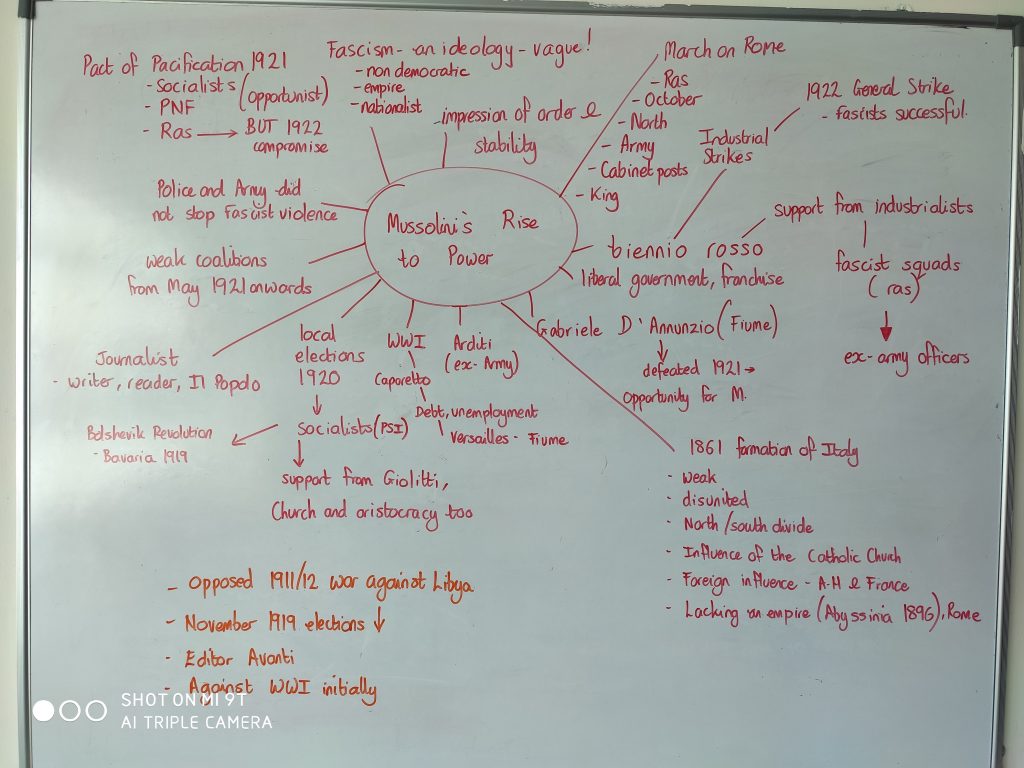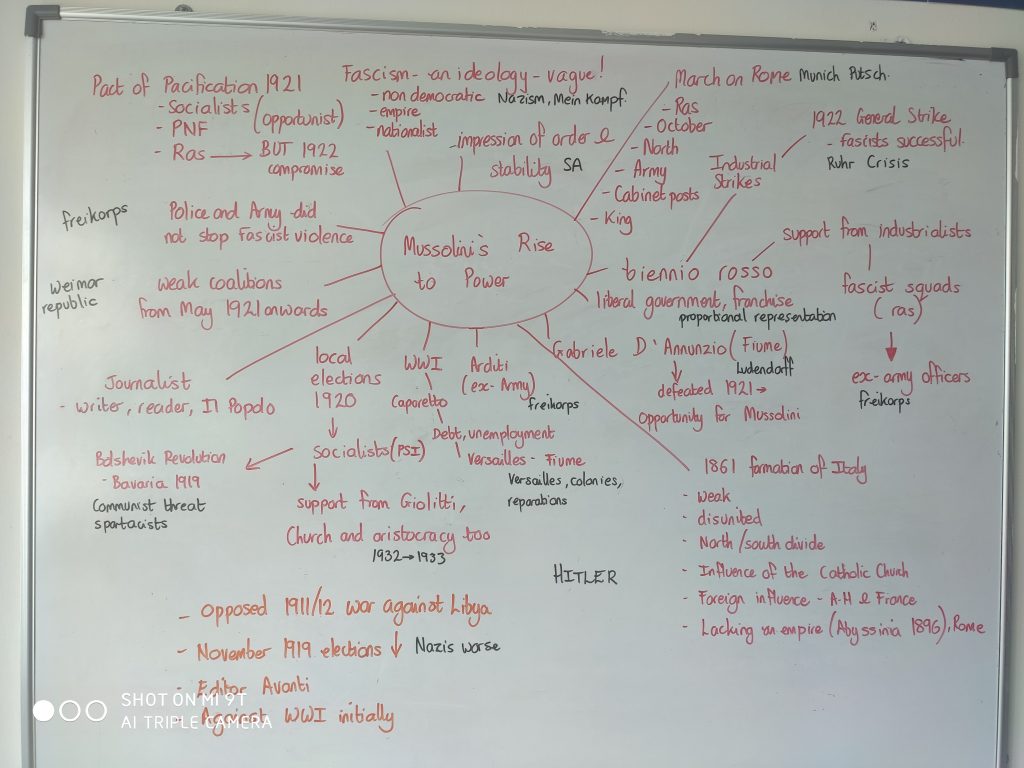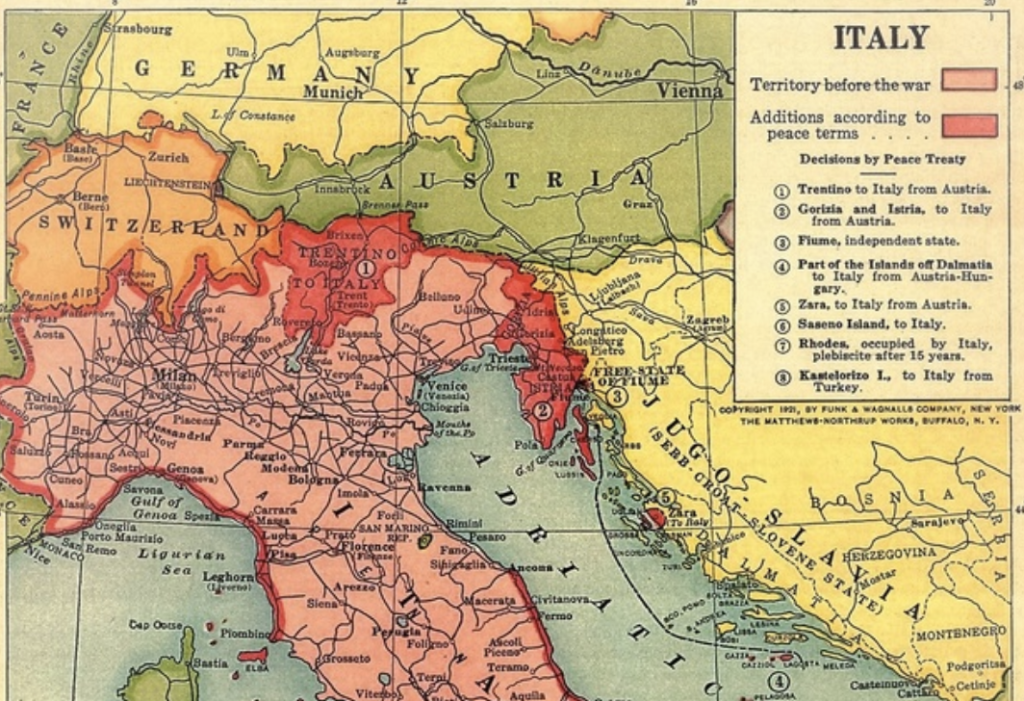Timeline
1861 Formation of an independent Italy.
1870 The Papal States incorporated into Italy
1911 Italy invades Libya
1912 Mussolini becomes editor of the Socialist newspaper Avanti
1914 First World War begins, Mussolini expelled from the Party
1915 Italy signs the Treaty of London
1917 Battle of Caporetto
1918 First World War ends
1919 Treaty of Versailles, Biennio Rosso years, Arditi begins, D’Annunzio takes Fiume.
1921 Mussolini forms national Bloc with Giolitti, Pact of Pacification with Socialists, formation of National Fascist Party with Mussolini its leaders.
1922 March on Rome, Mussolini appointed PM


- Mussolini was a nationalist and a socialist. He was editor of the socialist newspaper, Avanti, before he was expelled from the party for supporting Italian involvement in the First World War. Although he became a fascist, he was still a socialist and the Fascist manifesto reflected this, e.g. to introduce a minimum wage, reduce the retirement age and improve workers’ rights.
First World War
The following documentary is useful when putting Mussolini’s rise to power in context. It discusses the consequences of the First World War from European countries and how the conditions led to changes to the ‘Old World’. It is recommended you watch it all although if just for Mussolini, begin from 12.15.
After the First World War, new governments spread across Europe. From Republican democracies to Communism and Fascism. Italy was the first to swing to the latter.
- Italy joined the First World War in 1915 but there was not a huge amount of popular support for doing so. She was promised land in the Treaty of London by Britain, France and Russia.
- It suffered a series of defeats, the most notable being the Battle of Caporetto. There were 300 000 prisoners and 350 000 deserters.
- The military and political leadership got the blame for these defeats. One of the government’s placatory responses (one of the last acts by PM Orlando) was to offer the vote to all adult men. However, one of the downsides of proportional representation (also in Germany) was that extreme minorities could have a voice. Before 1914, the major political voices were either liberal or conservative. The male vote gave rise to socialists and communists. This led to political instability until 1922. Consequently, it was difficult to maintain a stable government because of the coalitions.
- Mussolini took advantage of these conditions to eventually make himself leader and dispose of the liberal democracy.
Fiume
History Today – Gabriele D’Annunzio’s Fiume Escapade

March on Rome
Versus History – The Rise of Mussolini
Khan Academy – Mussolini Becomes PM
Fascism
Mussolini was a socialist, a syndicalist, a nationalist, and then a fascist. Arguably, he combined his previous three beliefs into the final ideology.
Fascism is a concept far too easily used to describe politicians and governments. It is imperative that you read and understand the meaning so can accurately label the authoritarian leaders of the twentieth century. There are several articles online which you can read to help you understand fascism.
Umberto Eco: A Practical Guide for Identifying Fascists

Terry Eagleton’s What is Fascism argues that the concept is primarily used by governments to maintain the purest form of capitalism. It is also a strategy to keep the proletariat weak and the bourgeoisie strong. Fascists take advantage of an economic and/or political crisis and install an ambiguous ideological government. In the twentieth century, the latter involved the threat from the Left. If you argue Spain, Italy, Germany and Japan were fascist, the threat from the Soviet Union was used to help them become so. Fascism needs an enemy! (My words)
Eagleton explains that industries become monopolies in which they have a huge stake. Consequently, they can create a totalitarian state as a result, controlling all aspects of society. Free trade is restricted to protect these monopolies and, when the economy declines as a consequence, imperialist expansion becomes the next stage.
However, fascism is more than an economic policy. Politically, the country becomes more nationalistic and minorities are persecuted or scapegoated. Eagleton uses the example of Polish metal workers in Nazi Germany to prove this. Rather than keep these highly-skilled tradesmen for the economy, they were exterminated.
Modern History Sourcebook: Benito Mussolini: What is Fascism, 1932
Luck
- Mussolini achieved power because of several decisions made by other people – Italy joining the First World War (he supported it but it was not his decision to make).
- The Soviet Union and its communist ideology (obviously outside of Mussolini’s control) scared the middle and upper classes across the world. They were more likely to support nationalist groups, even if they were violent if they opposed any rise in socialism or communism.
Revision
